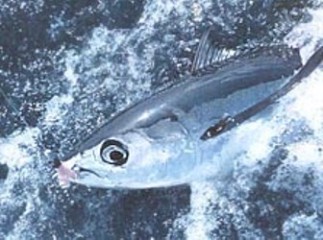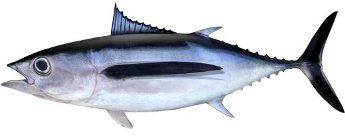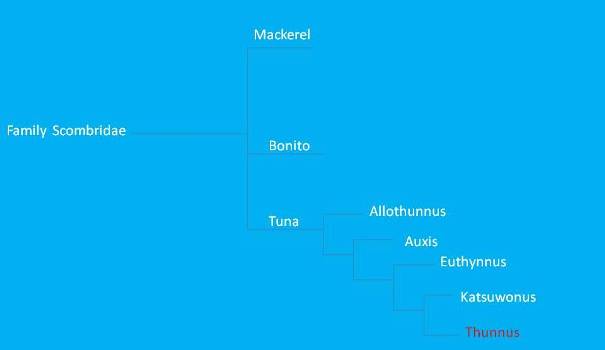Classification
Domain: Eukarya
Phylum: Chordata
Class: Actinopterygii
Order: Perciformes
Family: Scombridae
Genus: Thunnus
Species: Thunnus alalunga
Domain-Eukarya
Albacore tuna can be found in the domain eukarya because they are eukaryotic organisms. Some characteristics of being eukaryotic organisms means that they have a true nucleus as well as membrane bound organelles.
Kingdom-Animalia
They also are found in the Kingdom Animalia. They are a eukaryotic organism as stated above. They are also motile, as are most found in this kingdom. Also, Albacore tuna are heterotrophs, which mean they do not produce their own food and must ingest other organisms for food. They are also a multicellular organism and lack cell walls.
Phylum-Chordata

Albacore tuna are also part of the Phylum Chordata. They can be found under this phylum because they possess the five key features that all Chordates possess at some time in their development. These characteristics include a postnatal tail, a notochord, pharyngeal pouches, an endostyle (thyroid gland) and a dorsal nerve cord. They also have a true digestive tract and a true coelom which is fluid filled and lined with mesoderm. They are also triploblastic, which means they have all three tissue layers including an ectoderm, endoderm and a mesoderm. Lastly, they are bilaterally symmetric which means they are highly cephalized.
Class-Actinopterygii
Thunnus alalunga can be found in the Class Actinopterygii, which means ‘ray-finned fishes.’ Since the Albacore tuna have spiny fins, they are placed into this class. Other fish that can be found in this class include bass and minnows.
Order-Perciformes
Order Perciformes means ‘perch-like’. This order is usually characterized by having spines on the front of the dorsal and anal fins. They also have rough scales and possess pelvic fins made up of one spine and five rays. This is an extremely large and diverse group, including fish such as bluegill, tuna, bass and perch.
Family-Scombridae
 This family has many characteristics that make
it unique. First, this family is made up of mainly the food fish that
many people consume every day. They include fish like tuna, and also the bonitos and mackerels. They have two dorsal fins
and in most cases are predators in the sea.
All fish found in this family
have a high metabolic rate and also are continuous swimmers, which
means they must always be swimming or else they will die because
they lack a swimming bladder which helps with buoyancy.
This family has many characteristics that make
it unique. First, this family is made up of mainly the food fish that
many people consume every day. They include fish like tuna, and also the bonitos and mackerels. They have two dorsal fins
and in most cases are predators in the sea.
All fish found in this family
have a high metabolic rate and also are continuous swimmers, which
means they must always be swimming or else they will die because
they lack a swimming bladder which helps with buoyancy.
Genus-Thunnus
There are eight species that comprise the Genus Thunnus. These eight species include Yellowfin tuna, longtail tuna, Northern bluefin tuna, Southern bluefin tuna, Pacific bluefin tuna, Bigeye tuna, Blackfin tuna and of course Albacore tuna. These eight species can be pretty hard to distinguish between one another, but in some cases the morphology of the species can help determine the differences. For instance, the three bluefin species look somewhat similar and can be distinguished from other species such as the bigeye, albacore and yellowfin. To distinguish between these tuna however, molecular data such as DNA sequencing may have to be used.
Species-Thunnus alalunga
In English, Thunnus alalunga basically means a large pelagic tuna. The common name for this species is Albacore tuna and it can also be called ‘white meat tuna,’ which is the tuna you mainly find in canned goods in grocery stores. Another name for this species is long-finned tuna.
The following are phylogenetic trees that illustrate how the Albacore tuna, or Thunnus alalunga are related to other animals. The first tree shows how the Thunnus alalunga are related to other species of tuna. This phylogenetic tree is based off morphology. The Thunnus alalunga has a much longer pectoral fin than do the other species. The spleen can also be found on the right side of the viscera, while the other species have it on the left. This is why the Thunnus alalunga can be found on a lone branch. The 2nd phylogenetic tree is based off of the family that the Albacore tuna are found in, Family Scombridae. This Family is made up of tuna, mackerels and bonitos. There are 15 genera that make up the family, 5 of which are shown making up the tuna. Albacore tuna can be found in the Thunnus genera.

Picture modified
To see modification, click on photo



